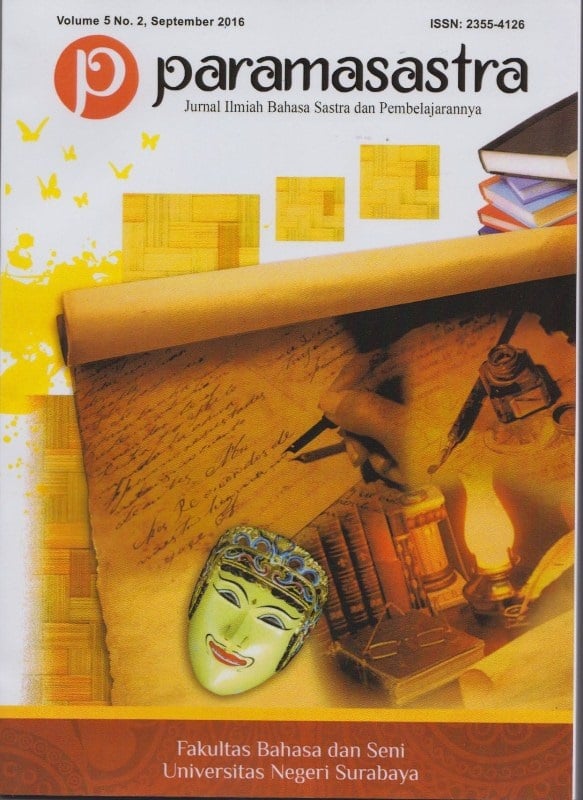KOLOKASI BERKONTRUKSI œNOMINA + VERBA DALAM BAHASA JEPANG PADA MINNA NO NIHONGO SHOKYUU DAN NIHONGO CHUUKYUU
DOI:
https://doi.org/10.26740/paramasastra.v5n2.p124-141Keywords:
collocation, syntatic role and type of collocationAbstract
This research is motivated by the existence of problems in language, because each language has their own habits to join the words with certain words. This habit is called collocation. The focuss in this study, is the use of collocation with the construction of "Nomina + Verba" and its role in Japanese in Minna no Nihongo Shokyuu and Nihongo Chuukyuu. Collocation with verb types is considered as the focus in this study, because verbs are 'lives' in a sentence. The results of this study indicate that the construction of nouns + verbs on Nihongo Shokyuu and Nihongo Chuukyuu are 4 constructions: (a) Noun + wo + Verba there are 3 roles of syntax, namely Objective, Locative and role of Time, (b) Noun + ni + Verb role found are Objective, Locative, Time, Opposition, Direction, Giver, Receiver and Results role roles, c) Noun + ga + role verbs which are objective-patient roles. This is because the construction that meets Nomina + Verba requirements is only in the patient role. Then the last one is construction (d) Nominal + de + Verba with 4 synthetic roles, Locatives role, Time, Instrument and cause / reason. The type of collocation studied is limited collocation, fixed collocation and idiom.References
Gatari, Adelia Febry. 2011. Kolokasi. Universitas Islam Negeri Syarif Hidayatullah.(http://repository.uinjkt.ac.id/dspace/bitstream/123456789/29117/1/SKRIPSI%20ADELIA%20FEBRY%20GATARI.pdf) diunduh pada 20 Februari 2017
Ikuo, Kawasse, Itou Yoshiteru, Koide Keiichi, dan Saita Izumi. 1996. Nihongo Chuukyuu I. Tokyo: The Japan Foundation
Ikuo, Kawase dan Saita Izumi. 1996. Nihongo Chuukyuu II. Tokyo: The Japan Foundation
Lee, Bunpei. 2016. Chuugokujin Nihongo Gakushuusha no Tame no Korokeeshon Gakushuu no Shidouhou ni Kansuru Kisotekikenkyuu Sakubun deeta n Kizuku (Meishi+wo+doushi) no Korokeeshon no Chuushin ni-. (Disertasi tidak dipublikasikan). Universitas Nagoya.
Ogawa, Iwao. 1998. Minna no Nihongo Shokyuu I. Surabaya: 3A Corporation
Roni. 2013. Peran-peran Pada Konstituen Tidak Wajib Hadir Non-Nomina Beserta Perwujudannya. (Artikel elektronik). Jurnal Asa:Jurnal Ilmiah Prodi Pendidikan Bahasa Jepang Seputar Bahasa, Sastra dan Pengajarannya (https://tentangroni.files.wordpress.com/2014/01/jurnal-nihongo-2013-10-jenis-jenis-peran-pada-nomina.pdf) diunduh pada 20 Juli 2018
Roni. 2014. Verba Sebagai Pusat Kalimat dalam Bahasa Jepang: Konsentrasi pada Makna Sintaksis Nomina Tidak Wajib Hadir. (Artikel elektronik) Jurnal Aktual: Jurnal LPPM Unesa. Vol. 1, No. 02, Juni 2014. ISSN 2339-2894. (https://tentangroni.files.wordpress.com/2009/04/artikel-jurnal-aktual.pdf) diunduh pada 20 Juli 2018
Sudjianto, dan Ahmad Dahidi. 2004. Pengantar Linguistik Bahasa Jepang. Jakarta: Kesaint Blanc Publishing.
Sutedi, Dedi. 2008. Dasar-dasar Linguistik Bahasa Jepang (Edisi Ketiga). Bandung: Humaniora
Yone, Tanaka, dan kawan-kawan. 2002. Minna no Nihongo II. Surabaya: 3A Corporation
Downloads
Published
How to Cite
Issue
Section
 Abstract views: 666
,
Abstract views: 666
, PDF Downloads: 2387
PDF Downloads: 2387












